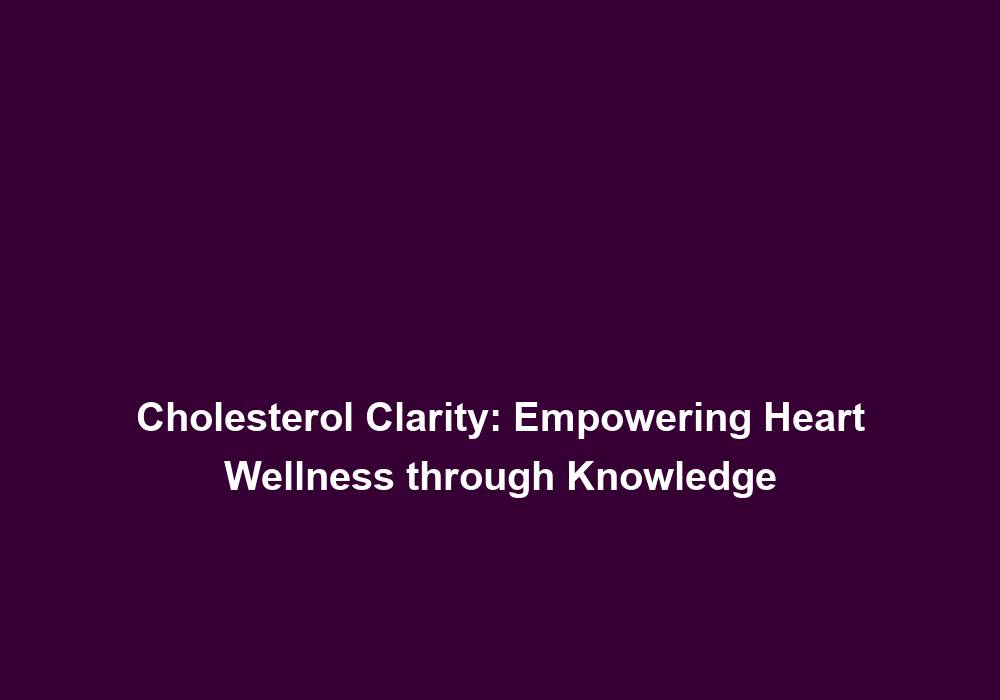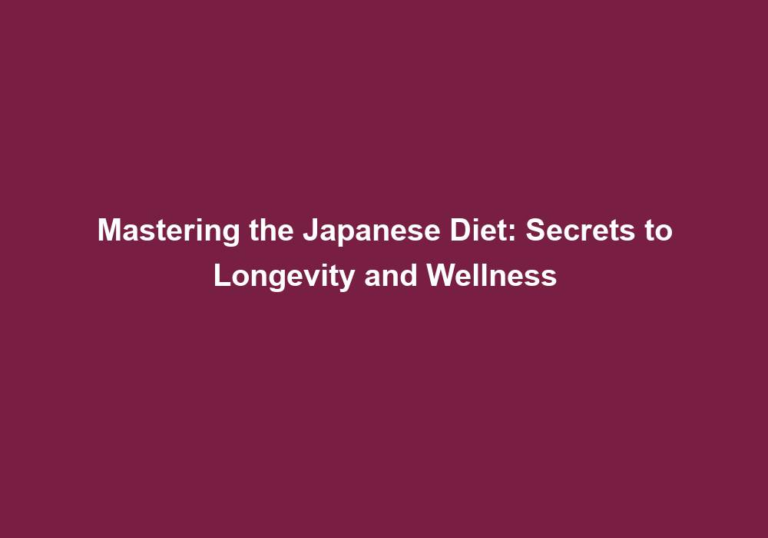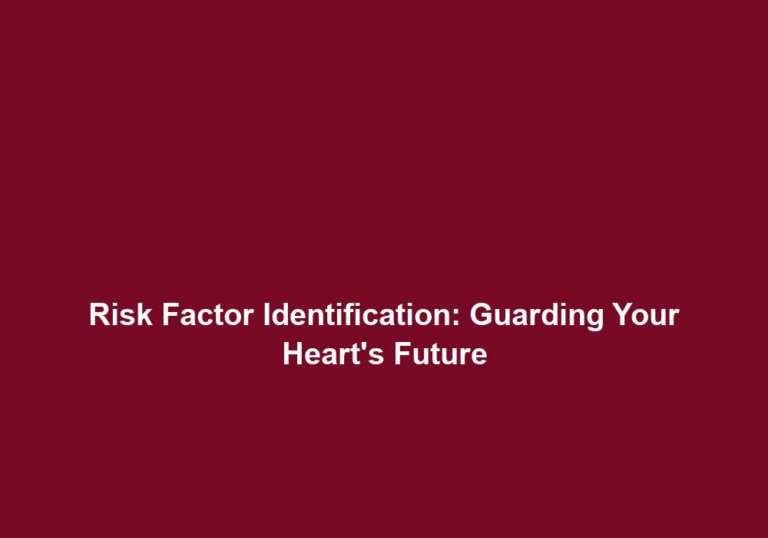Cholesterol Clarity: Empowering Heart Wellness through Knowledge
Cholesterol is a waxy, fat-like substance found in the cells of our body. It is often perceived as harmful, but it actually plays a crucial role in the production of hormones, vitamin D, and bile acids that aid in digestion. Cholesterol is synthesized by the liver and can also be obtained through certain foods we consume.
What is Cholesterol?
Cholesterol is a vital component of our bodies, serving various functions that are necessary for overall health. It is a structural component of cell membranes and plays a crucial role in the synthesis of hormones, including cortisol, estrogen, and testosterone. Cholesterol is also essential for the production of vitamin D, which is vital for bone health and immune function. Additionally, cholesterol is necessary for the synthesis of bile acids, which aid in the digestion and absorption of dietary fats.
The Good and the Bad: Understanding Cholesterol Types
Cholesterol can be classified into two main types: low-density lipoprotein (LDL) cholesterol, often referred to as bad cholesterol, and high-density lipoprotein (HDL) cholesterol, known as good cholesterol.
LDL Cholesterol
LDL cholesterol is considered bad because when its levels are high, it can lead to the accumulation of plaque in the arteries, a condition known as atherosclerosis. This buildup restricts blood flow and increases the risk of heart disease. Foods high in saturated and trans fats, such as red meat, fried foods, and processed snacks, tend to raise LDL cholesterol levels. It is important to limit the consumption of these foods and opt for healthier alternatives.
To lower LDL cholesterol levels, it is recommended to incorporate foods that are high in soluble fiber, such as oats, barley, fruits, and vegetables, into your diet. Soluble fiber helps reduce the absorption of cholesterol in the bloodstream. Additionally, consuming foods rich in omega-3 fatty acids, such as fatty fish like salmon and mackerel, can help lower LDL cholesterol levels. These fatty acids have been shown to reduce inflammation and improve heart health.
HDL Cholesterol
On the other hand, HDL cholesterol is often referred to as the good cholesterol as it helps remove excess cholesterol from the bloodstream, preventing the formation of plaque. Regular physical activity, consumption of foods rich in unsaturated fats (such as avocados, nuts, and olive oil), and refraining from smoking are all factors that can boost HDL cholesterol levels.
To increase HDL cholesterol levels, it is important to engage in regular aerobic exercise, such as brisk walking, jogging, or cycling. Exercise stimulates the production of enzymes that help transport cholesterol from the arteries to the liver for elimination. Consuming foods that are rich in monounsaturated and polyunsaturated fats, such as avocados, almonds, and fatty fish, can also help raise HDL cholesterol levels.
The Importance of Cholesterol Testing
Regular cholesterol testing is crucial in assessing your cardiovascular health. A simple blood test, known as a lipid profile, provides valuable insights into your cholesterol levels, including LDL, HDL, and triglycerides (another type of fat in the blood). It is recommended to test cholesterol levels at least once every five years for individuals above the age of 20.
Cholesterol testing allows healthcare professionals to evaluate your risk of developing heart disease and determine the most appropriate course of action. Based on the results, lifestyle modifications, such as dietary changes and increased physical activity, may be recommended. In some cases, medication may be prescribed to help manage cholesterol levels effectively.
Maintaining Healthy Cholesterol Levels
Managing cholesterol levels involves a comprehensive approach that combines healthy lifestyle habits and, if necessary, medical intervention. Here are some effective strategies to help maintain healthy cholesterol levels:
1. Adopt a Heart-Healthy Diet
Choosing a diet rich in fruits, vegetables, whole grains, lean proteins, and healthy fats can have a significant impact on cholesterol levels. Incorporating foods such as fish, legumes, nuts, and seeds, which are high in omega-3 fatty acids, can help lower LDL cholesterol levels. Additionally, reducing the consumption of saturated and trans fats found in processed foods is essential.
To follow a heart-healthy diet, it is important to focus on consuming whole foods that are low in saturated fats and cholesterol. Incorporating more plant-based proteins, such as beans, lentils, and tofu, can help reduce the intake of animal fats. Opting for cooking methods like grilling, baking, or steaming instead of frying can also help lower the overall intake of unhealthy fats.
2. Engage in Regular Physical Activity
Physical activity not only contributes to overall well-being but also helps raise HDL cholesterol levels while lowering LDL cholesterol and triglycerides. Aim for at least 150 minutes of moderate-intensity aerobic exercise or 75 minutes of vigorous activity per week, along with strength training exercises.
Incorporating exercise into your daily routine can have a positive impact on cholesterol levels. Activities like brisk walking, cycling, swimming, or dancing are all excellent choices. It is important to find activities that you enjoy and make them a regular part of your lifestyle. Additionally, incorporating strength training exercises, such as weightlifting or bodyweight exercises, can help build muscle mass and improve overall cardiovascular health.
3. Achieve and Maintain a Healthy Weight
Excess weight, particularly around the waistline, is often associated with higher LDL cholesterol and lower HDL cholesterol levels. By adopting a balanced diet and engaging in regular physical activity, it becomes easier to achieve and maintain a healthy weight range, thus promoting optimal cholesterol levels.
In order to achieve and maintain a healthy weight, it is important to focus on creating a calorie deficit through a combination of diet and exercise. This involves consuming fewer calories than you burn on a daily basis. It is important to emphasize portion control and choose nutrient-dense foods that provide satiety without excessive calorie intake. Incorporating regular physical activity into your routine will help increase calorie expenditure and support weight loss efforts.
4. Quit Smoking
Smoking damages blood vessels and lowers HDL cholesterol levels, making it even more important for smokers to quit this harmful habit. If you need assistance in quitting smoking, consult with your healthcare provider for guidance and support.
Smoking cessation is crucial for improving heart health and managing cholesterol levels. Quitting smoking has immediate and long-term benefits, including an increase in HDL cholesterol levels and a decrease in the risk of heart disease. There are various methods and resources available to support smoking cessation, including nicotine replacement therapy, medications, and behavioral counseling. It is important to seek professional help and develop a personalized plan to quit smoking successfully.
5. Medication and Medical Interventions
In some cases, lifestyle modifications alone may not be sufficient to manage cholesterol levels effectively. In such instances, healthcare professionals may prescribe medications, such as statins, to help lower LDL cholesterol. It is important to follow your healthcare provider’s instructions carefully and communicate any concerns or side effects.
Medications can be an important tool in managing cholesterol levels, especially for individuals with high-risk factors or genetic predispositions. Statins are commonly prescribed to lower LDL cholesterol levels and reduce the risk of cardiovascular events. It is important to work closely with your healthcare provider to determine the most appropriate medication and dosage for your specific needs. Regular monitoring and follow-up appointments are essential to assess the effectiveness and safety of the medication.
Conclusion
Understanding cholesterol and its impact on heart health is essential in empowering individuals to make informed decisions about their well-being. By adopting a heart-healthy diet, engaging in regular physical activity, maintaining a healthy weight, and quitting smoking, you can take proactive steps towards achieving and maintaining optimal cholesterol levels. Regular cholesterol testing and, if necessary, medical interventions can further support your journey towards heart wellness. Remember, knowledge is key when it comes to cholesterol clarity and heart wellness.







